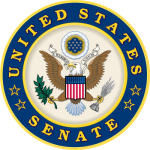- 産業: Government
- Number of terms: 4127
- Number of blossaries: 0
- Company Profile:
The United States Senate is the upper house of the United States Congress. The composition and powers of the Senate are established in Article One of the U.S. Constitution. Each U.S. state is represented by two senators, regardless of population. Senators serve staggered six-year terms.
The Constitution requires that a Senator be at least 30 years old, a citizen of the United States for at least nine years, and an inhabitant of the State from which he or she is elected. A person elected or appointed to the Senate and duly sworn is a Senator.
Industry:Government
A statutory provision that obligates funding for a program or agency. An authorization may be effective for one year, a fixed number of years, or an indefinite period. An authorization may be for a definite amount of money or for "such sums as may be necessary. " The formal federal spending process consists of two sequential steps: authorization and then appropriation.
Industry:Government
A motion to adjourn in the Senate (or a committee) ends that day's session.
Industry:Government
The principal vehicle employed by lawmakers for introducing their proposals (enacting or repealing laws, for example) in the Senate. Bills are designated S. 1, S. 2, and so on depending on the order in which they are introduced. They address either matters of general interest ("public bills") or narrow interest ("private bills"), such as immigration cases and individual claims against the Federal government.
Industry:Government
A proposed law passed by Congress must be presented to the President, who then has 10 days to approve or disapprove it. The President signs bills he supports, making them law. He vetoes a bill by returning it to the house in which it began, usually with a written message. Normally, bills he neither signs nor vetoes within 10 days become law without his signature.
Industry:Government
Each party policy committee provides research and other services to Senators and also serves as a forum for discussion of party legislative strategy. Each policy committee holds weekly lunches for party members, and the Senate normally takes a recess to allow Senators to attend.
Industry:Government
The number of Senators that must be present for the Senate to do business. The Constitution requires a majority of Senators (51) for a quorum. Often, fewer Senators are actually present on the floor, but the Senate presumes that a quorum is present unless the contrary is shown by a roll call vote or quorum call.
Industry:Government
Subunit of a committee established for the purpose of dividing the committee's workload. Recommendations of a subcommittee must be approved by the full committee before being reported to the Senate.
Industry:Government
The fiscal year is the accounting period for the federal government which begins on October 1 and ends on September 30. The fiscal year is designated by the calendar year in which it ends; for example, fiscal year 2006 begins on October 1, 2005 and ends on September 30, 2006. Congress passes appropriations legislation to fund the government for every fiscal year.
Industry:Government
A meeting of a committee or subcommittee -- generally open to the public -- to take testimony in order to gather information and opinions on proposed legislation, to conduct an investigation, or review the operation or other aspects of a Federal agency or program.
Industry:Government
